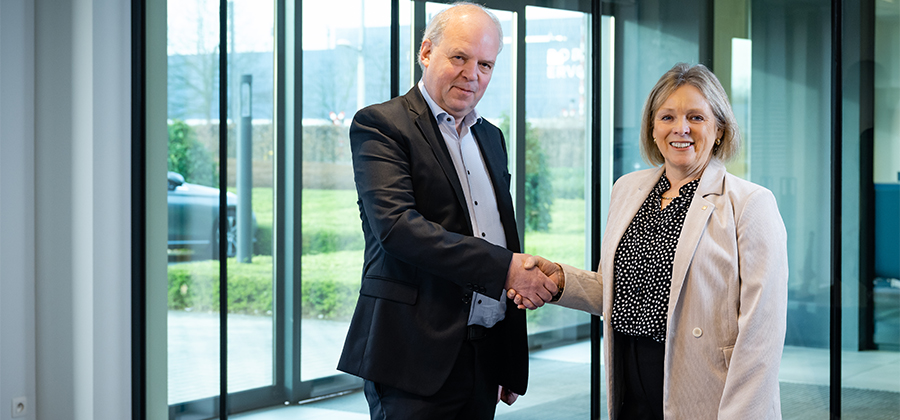With the cities of tomorrow incorporating large-scale digitalisation, a new participatory eco-system is currently on the rise. Digital technology already offers citizens the possibility of taking part in city life. Very soon, it will become a means of inclusion. The smart city won't leave anyone behind.

By significantly increasing the capacity for communication and connectivity between individuals, digital technology is driving the collaborative economy and leading to the emergence of a new social model, less consumer-oriented and based on sharing. The city of tomorrow will not lose its soul because of the greater use of technology. Quite the opposite. Whether in matters of education, citizen action, supporting marginalised groups or even looking after the elderly, digital technology enables new solutions to be implemented.
Applications and platforms have become effective vectors for driving social innovation and making it easier to share. The key principles of collaboration and participation are intrinsic to the concept of the smart city, since hyper-connectivity links everyone together. It's a paradigm shift. If the smart city is to work well and fulfil all its promises, it must be built on a new, more inclusive model. Digital technology now offers a significant number of possibilities to make cities more cohesive.
Sharing economy
The collaborative economy will reach 570 billion euros by 2025
Development of the collaborative economy has accelerated considerably over the past few years. It can now be found in all types of communities. Its evolution into a complete and separate economic model has been supported by digital platforms, which provide it with the ideal infrastructure. Moreover, by establishing itself as a parallel economy and an alternative to the crisis, more and more people are being convinced. Whether you want to find a job, offer your services or sell something, all you need to do is log in. Disrupting the economy is now as easy as getting on to the internet.
If you believe the statistics published by auditing firm PwC, it's a booming market. The total amount of transactions in the collaborative economy currently stands at 28 billion euros and could, according to the latest estimates, grow twenty-fold to reach 570 billion euros by 2025. Bold figures that attest to a real increase in power. Start-ups have recognised the many advantages to be gained from this new market and are developing more projects in this area, giving greater impetus to the emergence of the collaborative model. Hence the social network Smiile, supported by the French insurance company MAIF, offers its members a whole range of services, from car-pooling, to group purchases and sharing goods and skills, it was designed to be driven by proximity and exchange. Smiile currently has 340,000 members and aims to reach a million within a few months.
Expert view
"We want to go beyond the purely virtual aspect of social networks by enabling those who live in the same neighbourhood to meet and create social links"
David Rouxel, Founder of Smiile
But this new type of social network is not simply restricted to connecting individuals. It is also an integration platform for start-ups and businesses in the collaborative economy. It has formed partnerships with almost 7,000 manufacturers and traders for their group buying offers, and also with companies such as Koolicar in order to secure a quality shared mobility service for its members. Even more significantly, David Rouxel, the founder of Smiile, is simultaneously developing Smiile City, which uses the same model but is aimed at town halls, local authorities and housing associations. It reinforces dialogue between residents of the same neighbourhood to make it easier for them to report specific problems, such as those to do with the road network for instance, by flagging information up to the mayor. Already piloted in several eco-neighbourhoods, Smiile City wants to become the indispensable tool for the smart city of tomorrow.
In the cities of the future, applications will have a special place. On the one hand, because their use will be made even easier and they will reach even more people due to hyper-connectivity. On the other, because they constitute a response to fears about massive job losses and the vulnerability felt by less highly-skilled workers. And there's more. Digital technology goes even further than reshuffling the cards in the world of work.
Fighting exclusion
By digitalising its neighbourhoods, the Smart City will be able to better identify and account for marginalised groups. Digitalisation will bring considerable improvement to the living conditions of these groups thanks to an applications ecosystem. People suffering exclusion will therefore have a panel of specific Web 2.0 services at their disposal.
A very specific example: the English IT engineer and start-up founder Alex Stephany has just launched the Beam platform, short for 'Be Amazing', in order to help homeless people transform their lives. Beam is a social crowdfunding site which aims to raise funds and enable people who have their sights set on finding a job to get training or return to education. Beam uses the same model as all job centres everywhere: a manager is allocated to each member to take stock of their skills and professional aspirations in order to set up training opportunities. Then a budget is drawn up which includes all the necessary costs, such as accommodation, food and transport. Next the crowdfunding campaign is launched using targeted messaging supported by social networks, as well as distributing newsletters for each project.
Another relevant initiative that foreshadows what tomorrow may bring in using digital technology to care for the most disadvantaged is the Youth Homeless Databank, launched in England in 2016. It aims to provide accurate data on young rough sleepers so they can be cared for more effectively by social services.
Thanks to an application that pools data from local councils, welfare organisations and accommodation providers, it is possible to learn how many young people are living in vulnerable circumstances, and who and where they are. By sending this information to associations working with the homeless, the Youth Homeless Databank now plays a central role in helping to find them accommodation and reintegrating them into society. Here digital technology forms a link between institutions and associations, helping them to work more effectively in the field.
Finally, the increasing potential of the sharing economy and Web 2.0 solidarity undoubtedly only illustrates the transformations in the world of employment and social upheavals that Jeremy Rifkin foresaw in The Third Industrial Revolution. Better care can be provided for elderly people, both now and in the future, thanks to the internet of things and applications that monitor their health in real time. Vulnerable groups are better identified and more easily supported; the unemployed can find work thanks to collaborative platforms. African, Asiatic and South American countries can keep up thanks to Fab Labs which drive local social innovation and focus on 'co-making' and 'co-decision'. All this progress associated with the digital world represents the building blocks of the smart city, which, if it wants to fulfil its potential, must include as many citizens as possible in its project. The city of tomorrow will be collaborative and inclusive if it truly wants to become a reality.
Source : L’Atelier
16.12.2024
The digital divide persists
“It's not just the elderly who lack digital skills, young people and workers are also affected,” says Linde Verheyden, Director Public Affairs at BNP Paribas Fortis and Chair of DigitAll.
Despite the acceleration in digitalisation, many people are being left behind. In Belgium, 40% of the population between the ages of 16 and 74 are at risk of digital exclusion. Although older people are often seen as the most vulnerable group, younger people are also struggling in the digital age. Among young people aged between 16 and 24, almost a third lack basic digital skills, with a peak of 52% among those with a low educational attainment.
Figures that are surprising to say the least, considering young people grow up surrounded by digital tools.
"People often assume that young people are digital natives because they are adept at using social media. But making a TikTok video or scrolling through your Instagram feed doesn't necessarily mean you know how to carry out online banking transactions or complete an application form.
Does poverty play a significant role in the digital divide?
"Absolutely. For 25% of people living in poverty, a smartphone is their only digital device. Although they provide a basic form of access, smartphones are often inadequate for important tasks such as preparing a CV or filing a tax return. Without a computer or a stable internet connection, many digital opportunities remain out of reach for those who don't have access to these tools.
What are the other reasons for this digital divide?
"People often lack the necessary basic digital skills because they never learned them. They may not know how to use a search engine, attach a file to an e-mail, or download an app. Without this knowledge, the digital world becomes inaccessible. Furthermore, there is also the issue of digital stress. Many people worry about making mistakes, being hacked, or their privacy. Some people deliberately choose not to use digital services even though they have the skills. Technology instils a sense of distrust and unrest in them, creating a significant barrier.”
How can companies help close this gap?
"Companies can play a key role on several levels. In addition to being a social problem, digital exclusion is also an economic challenge. Today, less digitally adept individuals are both customers and potential employees. Being aware of this as a company is the most important first step. But it’s also essential to provide support to your staff. For example, employees at the municipal parks and greenery service in Ghent received training on how to file their tax returns online. These kinds of initiatives give people practical skills and confidence. In addition, companies need to do a digital check. To measure is to know. Just because someone uses a laptop daily, it doesn’t mean they have digital skills."
What does BNP Paribas Fortis do specifically to promote digital inclusion?
"We have launched several initiatives. In 2020, we established DigitAll, a platform for sharing knowledge and best practices around digital inclusion. Today, we bring together more than 130 organisations. DigitAll has developed a range of tools, including a checklist that companies can use to test how accessible their apps and websites are. A simple interface can make the difference between joining or dropping out for people who are less digitally adept. Since 2021, the bank has also supported a chair at the VUB that investigates the link between digital inclusion and human rights."
How important are tools in bridging the digital divide?
"User-friendly tools are a must. We have partnered with Emporia, a manufacturer of user-friendly smartphones for the less digitally adept. We pre-install our app for customers who buy one of their smartphones."
We mentioned digital stress earlier. How can you mitigate this?
"With awareness campaigns. We want our customers to use our tools with confidence. The bank also takes its less digitally adept customers into account. Thanks to our partnership with bpost, all our customers can go to their local post office for all basic banking transactions."
Do companies stand to benefit from promoting digital inclusion?
"They do. Digital inclusion requires a sustained effort from all stakeholders, including governments and educational institutions. No one should be left behind. Companies that act now can contribute to a more inclusive society while also securing their own future in an increasingly digital world.”
“Without key digital skills, many digital opportunities remain out of reach.”
“A simple interface can make the difference between joining or dropping out for people who are less digitally adept.”
“Limited digital skills remain an obstacle to closing the digital divide.”
Linde Verheyden, Director Public Affairs at BNP Paribas Fortis and Chairman of DigitAll
16.05.2024
Kazidomi: a healthy online supermarket
A subscription to build customer loyalty, reinvent yourself in times of crisis and buy better: Emna Everard saw that as exactly the right way to launch and maintain her Brussels-based start-up.

Born into a family of dietitians, Emna Everard knows what it means to eat healthily. "At the age of 12, I was already deciphering packaging labels. My dream was to open a supermarket one day where you could shop with your eyes closed", she recalls.
And because Everard has entrepreneurship in her bones, that’s exactly what she did. In 2016, just before the end of her university studies, she launched the “healthiest online supermarket on the market”: Kazidomi. Her standards are high, both in terms of composition and taste. Kazidomi selects products carefully, enabling its customers to buy healthy, mainly organic, plant-based products with complete confidence.
The loyalty programme
Six months after its launch, Kazidomi’s growth is accelerating thanks to the launch of its loyalty programme. A 59 euro subscription offering 20–50% discounts on all food, cosmetics or care products available online. Profitability and savings guaranteed.
This was followed by a first fundraising of €50,000 in 2017. Kazidomi is growing, expanding the size of its stock and developing its marketing. Everard hired her first two employees. Sales grew rapidly and literally exploded during the COVID-19 pandemic. "Consumers suddenly had time to think about their health and well-being and were doing most of their shopping online," she adds.
How did you reinvent yourself?
The post-crisis period was a turning point. "Kazidomi had to reinvent itself. We wanted to have financial stability and avoid any dependence on external resources," continues Everard. Together with her teams, she looked at their cost structure, operational efficiency and marketing. After these reflections, the aim was no longer growth at any price, but the company's long-term viability and financial health, thanks to an intelligent reorganisation.
Two acquisitions would subsequently enable Kazidomi to boost its growth, creating significant synergies: "Smart Fooding" in August 2022 and "Bébé au Naturel" a few months later, a business specialising in healthy products for babies and their parents. "With Bébé au Naturel, we doubled the volume of orders sent out," adds Everard. "This has allowed us to get a better rate from our carriers and reduce costs."
A responsive and attentive bank
As the Brussels start-up’s bank, BNP Paribas Fortis granted it three loans for its launch, between 2016 and 2019. This support came naturally, with Kazidomi’s commitments in terms of Environmental, Social and Governance (ESG) objectives perfectly aligned with the bank’s strategy. "We joined the BNP Paribas Fortis Innovation Hub programme and our relationship manager – who knew the start-up environment extremely well – was immediately enthusiastic and very attentive. He believed in our project, followed it closely, advised us to participate in a series of events to meet other players whose background and profile would be of interest for us," explains the Entrepreneur of the Year 2019.
But the support didn't stop there. "In December 2022, it was thanks to BNP Paribas Fortis, among other things, that we were able to acquire “Bébé au Naturel”. Start-ups like Kazidomi need a high level of responsiveness from their bank. When there is a company to buy, or another opportunity, things have to move fast. Analysis of the file, provision of funds: BNP Paribas Fortis has always been responsive and enthusiastic and has supported us in 99% of our requests," says the CEO enthusiastically.
|
Eight years since launching, Kazidomi today has 4,000 products that it delivers across Europe. The Belgian start-up makes 90% of its sales on its website and 10% via external resellers, such as Delhaize. Kazidomi has also launched its own brand “Kazidomi”, which has 200 products on offer. By working directly with producers, we can offer the best possible quality products at the best price. |
Kazidomi is ready to change the world. Discover even more inspiring entrepreneurial stories.
14.05.2024
Less CO2 and healthier food
Cosucra is investing in the decarbonisation of its production processes. Their focus is on using fibre and plant-based protein from chicory and peas for a healthy and less polluting diet.
Belgium’s Hainaut-based Cosucra has been operating since 1852. The company is quite small with 365 employees, but its activities have evolved over time. From the 1980s onwards, sugar beet processing gave way to chicory and yellow peas. Also, sugar was replaced by inulin and pea protein.
"Many families lack the time to put a fresh meal on the table every day. With our products, the industry can offer them easy, quick and nutritious meals," says Eric Bosly, CEO of Cosucra. "Nutritionists stress the importance of fibre and plant proteins for health, and such a diet has a positive impact on our carbon footprint."
New investors
To take their decarbonisation a step further, in 2023, the company launched a seven-year investment plan worth EUR 150 million. “We are keenly aware of the climate crisis, so we wanted to make this transition fast,” says Bosly. “That's why we brought three investors on board who share our values and are willing to commit in the longer term.”
Long-term relationship
Cosucra and BNP Paribas Fortis have a long-standing partnership. "The bank has supported us in expanding to Denmark and the United States. It's of great value to have the same contact person for setting up the financial structure of subsidiaries, opening accounts abroad, etc. We also meet regularly, which means we can count on the expertise of teams specialised in the food industry. Their macro vision complements that of our local account managers who know our business well."
Same market conditions
Cosucra’s efforts will result in a 55% reduction in CO2 emissions within three years. Yet, decarbonisation is just one of Bosly’s bold ambitions. "We are pushing for the same market conditions as animal proteins. Why, for example, is 20 per cent VAT levied on pea-based milk while for cow’s milk, this figure is under 6 per cent? Plant-based products are also more expensive because you can't achieve economies of scale due to the lower quantities required. If you consider all the “negative external effects” of animal products on human health and the environment, our sector deserves support until we reach a certain scale."
Change of mindset
The entrepreneur also laments how the retail sector uses meat as a decoy product, lowering its margins to offer consumers an attractive price. "In times of inflation, that price difference is all the more detrimental to us. This is why a change of mindset is essential. Nutritionists say that a weekly serving of just 200 to 250 grammes of meat is enough to get the nutritional benefits with no negative impact. But at the moment, most Belgians consume 200 grammes of meat per day."
Bosly also cites competition from imported agricultural products as an obstacle.
Cosucra is ready to change the world. Discover even more inspiring entrepreneurial stories.
"The European Green Deal aims to reduce inputs by half, leading to the ban of many herbicides, among other things. Farmers should be supported in this transition. And a company like Cosucra, which buys chicory and peas within a 200-kilometre radius, is not on an equal footing with strong Chinese competition."
13.05.2024
Brepols prepares for the future
Since 1796, Brepols has been producing diaries that allow you to better plan your time. The team is fully committed to people, the planet and prosperity.

"From Turnhout to a branch in Paris, our 110 employees create tools that help our customers manage their time better. And that benefits their work-life balance," says Finance Director Philippe Pissens. "Quality, craftsmanship and creativity are at the heart of our products. Brepols’ diaries, calendars and notebooks are not disposable products - they easily last a year. We also make business leather goods under the Maverick brand and and we have launched a brand-new collection of high-quality notebooks under the brand name "de KEMPEN". In addition, we distribute the famous Moleskine notebooks. Finally, there are our bookbinding activities," he says. Brepols’ main markets are the Benelux and France.
Financially on track
Since starting out in 1796, Brepols has seen many trends and developments come and go. The last few years have been marked by growth. This is thanks to the Financial Director, who came on board in 2000. With turnover of EUR 17.4 million in 2021, EUR 19.6 million in 2022 and EUR 20.8 million last year, the company is clearly on the right financial track. "These figures are not just a result of price increases. We are a strong company with a solvency of 70 per cent, which means that we only finance 30 per cent with external funds," he explains.
More than planting trees
"Since 2009, we have only used Forest Stewardship Council (FSC)-labelled paper. For every tree cut down, a new one replaces it. But there's always room for improvement. In 2022, we launched a project group comprising staff across the company. We call it P3, because we focus on people, the planet and prosperity."
The project group analysed the company’s strengths and weaknesses, with the employers’ organisation Voka acting as a sounding board. “We certainly didn't want to make the mistake of greenwashing,” says Pissens. Specifically, Brepols developed 18 action points, which means it already covers nine of the 17 Sustainable Development Goals. In addition to a charter, there is a code of conduct that suppliers must sign and respect. Other initiatives include focusing on local production, limiting residual waste, reducing energy consumption and developing a HR policy that takes diversity and inclusion into account. “The aim of this project group is to create internal and external support and communicate clearly with all our stakeholders.”
Fluid organisation
"Honesty and transparency towards our employees are top priority," Pissens continues. "We have intensive consultations with them, both formal and informal. We deliberately opt for a fluid organisational model, between the hierarchy and the self-managing teams, and there has been a high level of participation. This is crucial as a quarter of our employees will be retiring in the next three years. In this context, we also purchased cobots, which makes the work less physically demanding for our staff."
Clear communication
Pissens emphasises the importance of clear communication to all stakeholders, including its financial partners, such as BNP Paribas Fortis. "The bank has become key to our business operations. We provide our relationship manager with detailed figures and keep her up to date with our sustainable ambitions. Our contacts at BNP Paribas Fortis not only provide us with information about financial products; they also give us tips, such as measuring our energy consumption and the possibilities for subsidies to install solar panels, for example. We have an effective two-way communication. Our collaboration has grown into a real partnership. In our business, paying attention to Environmental, Social, Governance (ESG) aspects is the benchmark in every consultation," Pissens concludes.
Quote
"The bank has become a key figure in our business operations”
Philippe Pissens, Finance Director Brepols
Brepols is ready to change the world. Discover even more great stories from entrepreneurs.
